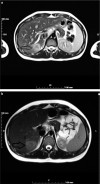Rare association of solitary necrotic nodule of the liver with rheumatoid arthritis and systemic lupus erythematosus
- PMID: 36843896
- PMCID: PMC9951897
- DOI: 10.14744/hf.2022.2022.0020
Rare association of solitary necrotic nodule of the liver with rheumatoid arthritis and systemic lupus erythematosus
Abstract
Solitary necrotic nodule of the liver (SNNL) is a rare benign lesion with uncertain etiology characterized by a "completely necrotic core" and a hyalinized capsule containing elastin fibers (Journal of Clinical Pathology 36:1181-1183, 1983). We report herein a 26-year-old woman with a previous diagnosis of rheumatoid arthritis, systemic lupus erythematosus, and Sjögren's syndrome and no history of malignancy who presented with a complaint of diarrhea of 1-year duration. In the abdominal ultrasound, multiple paraaortic, portocaval, and ileal lymphadenopathies (LAPs) have been found with the largest one being 2 cm in size. The biopsy of the iliac LAP showed reactive nodular hyperplasia. An abdominal CT disclosed an incidental hypoechoic, heterogenous mass sized 27 × 27 mm close to segment VI of the liver. A trucut biopsy of this lesion was made, and clinicopathologic features of the specimen were compatible with a solitary necrotic nodule of the liver. Here, we discuss the diagnosis and the clinical course of this rare entity in light of current literature.
Keywords: Solitary necrotic nodule of the liver; rheumatoid arthritis; systemic lupus erythematosus.
© Copyright 2023 by Hepatology Forum.
Conflict of interest statement
The authors have no conflict of interest to declare.
Figures



Similar articles
-
Enlarged solitary necrotic nodule of the liver misinterpreted as a metastatic liver cancer.Clin J Gastroenterol. 2009 Oct;2(5):355-360. doi: 10.1007/s12328-009-0103-y. Epub 2009 Sep 2. Clin J Gastroenterol. 2009. PMID: 26192613
-
Solitary necrotic nodules of the liver with "ring"-like calcification: A case report.World J Clin Cases. 2022 Jul 26;10(21):7409-7414. doi: 10.12998/wjcc.v10.i21.7409. World J Clin Cases. 2022. PMID: 36158018 Free PMC article.
-
Solitary necrotic nodule of the liver: a riddle that is difficult to answer.J Gastrointest Surg. 2003 Jul-Aug;7(5):627-30. doi: 10.1016/s1091-255x(02)00142-7. J Gastrointest Surg. 2003. PMID: 12850674 Review.
-
A case of solitary necrotic nodule treated with laparoscopic hepatectomy: spontaneous regression of hepatocellular carcinoma?Case Reports Hepatol. 2013;2013:723781. doi: 10.1155/2013/723781. Epub 2013 Mar 19. Case Reports Hepatol. 2013. PMID: 25431705 Free PMC article.
-
Solitary necrotic nodule of the liver: imaging features, differential diagnosis and management.Eur J Radiol. 2025 Feb;183:111869. doi: 10.1016/j.ejrad.2024.111869. Epub 2024 Dec 3. Eur J Radiol. 2025. PMID: 39647273 Review.
References
-
- Zimmermann A. 1st ed. Berlin: Springer; 2017. Tumors and tumor-like lesions of the hepatobiliary tract: General and surgical pathology.
-
- Kondi-Pafiti AI, Grapsa DS, Kairi-Vasilatou ED, Voros DK, Smyrniotis VE. “Solitary” necrotic nodule of the liver: an enigmatic entity mimicking malignancy. Int J Gastrointest Cancer. 2006;37(2-3):74–78. - PubMed
-
- Zhou YM, Li B, Xu F, Wang B, Li DQ, Liu P, et al. Clinical features of solitary necrotic nodule of the liver. Hepatobiliary Pancreat Dis Int. 2008;7(5):485–489. - PubMed
-
- Deniz K, Coban G. Solitary necrotic nodule of the liver: always benign? J Gastrointest. 2010 Surg;14(3):536–540. - PubMed
Publication types
LinkOut - more resources
Full Text Sources
Molecular Biology Databases
Research Materials
